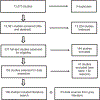IDF Diabetes Atlas: Global, regional and country-level diabetes prevalence estimates for 2021 and projections for 2045
- PMID: 34879977
- PMCID: PMC11057359
- DOI: 10.1016/j.diabres.2021.109119
IDF Diabetes Atlas: Global, regional and country-level diabetes prevalence estimates for 2021 and projections for 2045
Erratum in
-
Erratum to "IDF Diabetes Atlas: Global, regional and country-level diabetes prevalence estimates for 2021 and projections for 2045" [Diabetes Res. Clin. Pract. 183 (2022) 109119].Diabetes Res Clin Pract. 2023 Oct;204:110945. doi: 10.1016/j.diabres.2023.110945. Epub 2023 Oct 19. Diabetes Res Clin Pract. 2023. PMID: 37863776 No abstract available.
Abstract
Aims: To provide global, regional, and country-level estimates of diabetes prevalence and health expenditures for 2021 and projections for 2045.
Methods: A total of 219 data sources meeting pre-established quality criteria reporting research conducted between 2005 and 2020 and representing 215 countries and territories were identified. For countries without data meeting quality criteria, estimates were extrapolated from countries with similar economies, ethnicity, geography and language. Logistic regression was used to generate smoothed age-specific diabetes prevalence estimates. Diabetes-related health expenditures were estimated using an attributable fraction method. The 2021 diabetes prevalence estimates were applied to population estimates for 2045 to project future prevalence.
Results: The global diabetes prevalence in 20-79 year olds in 2021 was estimated to be 10.5% (536.6 million people), rising to 12.2% (783.2 million) in 2045. Diabetes prevalence was similar in men and women and was highest in those aged 75-79 years. Prevalence (in 2021) was estimated to be higher in urban (12.1%) than rural (8.3%) areas, and in high-income (11.1%) compared to low-income countries (5.5%). The greatest relative increase in the prevalence of diabetes between 2021 and 2045 is expected to occur in middle-income countries (21.1%) compared to high- (12.2%) and low-income (11.9%) countries. Global diabetes-related health expenditures were estimated at 966 billion USD in 2021, and are projected to reach 1,054 billion USD by 2045.
Conclusions: Just over half a billion people are living with diabetes worldwide which means that over 10.5% of the world's adult population now have this condition.
Keywords: Diabetes; Epidemiology; Health economics; International Diabetes Federation; Prevalence; Projections.
Copyright © 2021. Published by Elsevier B.V.
Conflict of interest statement
Declaration of Competing Interest The authors declare that they have no known competing financial interests or personal relationships that could have appeared to influence the work reported in this paper.
Figures





References
-
- Chan JCN, Lim L-L, Wareham NJ, Shaw JE, Orchard TJ, Zhang P, et al. The Lancet Commission on diabetes: using data to transform diabetes care and patient lives. Lancet 2020;396 (10267):2019–82. - PubMed
-
- Guariguata L, Whiting D, Weil C, Unwin N. The International Diabetes Federation diabetes atlas methodology for estimating global and national prevalence of diabetes in adults. Diabetes Res Clin Pract. 2011;94:322–32. - PubMed
-
- Stevens GA, Alkema L, Black RE, Boerma JT, Collins GS, Ezzati M, et al. Guidelines for Accurate and Transparent Health Estimates Reporting: the GATHER statement. Lancet 2016;388 (10062):e19–23. - PubMed
MeSH terms
Grants and funding
LinkOut - more resources
Full Text Sources
Other Literature Sources
Medical

